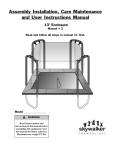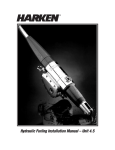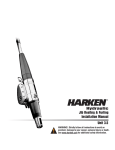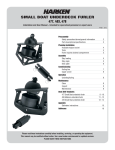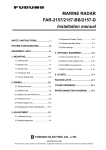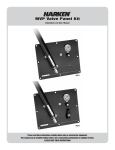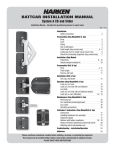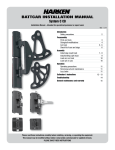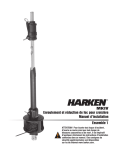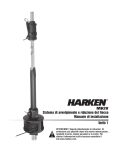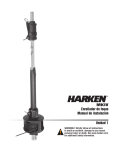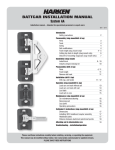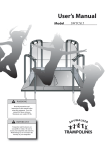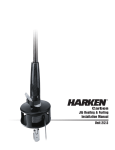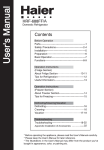Download NAUTOR MKIV Jib Reefing & Furling Installation Manual
Transcript
NAUTOR MKIV Jib Reefing & Furling Installation Manual C8436/C8437 Parts 2' (610mm) Bottom Foil 7' (2.13m) Foils Halyard Swivel Connector Bushings Trim Cap Plastic Connector Wedges Foil Screws Connectors Bottom Connector Bow Shackles Prefeeder Feeder 3,4, 6, 10mm Allen Wrenches Drum Assembly Toggle/Terminal Assembly Other Components Part No. 7413.31 Main Components Part No. Quantity Description H-43184 1 Drum assembly with clamp H-39392 1 Halyard swivel Foils (Standard Package) Part No. 7413.30 7413.33 Quantity C8436 (9) C8437 (10) 1 Description 7'(2.13m) Foil 2'(610mm) Botton foil (shipped in drum box) Tools Quantity 1 Each 03/10/11 Description 3, 4, 6, 10mm Allen wrenches Blue Loctite® Quantity Injector 5200 Adhesive Description C8436 (8) 9.75" (248mm) Connector C8437 (9) 7413.32 1 14" (356mm) Bottom connector HFG297 1 Connector bushing set (20 each H-42073/H-42074)* HFG324 1 Plastic connector wedge set (22 39487) HFG349 1 Foil screw set (44 HFS1106) HFG682 1 Trim cap set (H-39751/H-39752) Prefeeder 947 1 H-39756 1 Feeder with screw and tab 2124 3 10mm Bow shackle HFG725 1 Injector HFG722 1 1 oz. 5200 Adhesive 833 1 Blue Loctite ® *One extra H-42073 and H-42074 sent with C8437 Nautor MKIV Furling 3 Preassembly Headstay Length HEADSTAY CUT LENGTH Subtract the following from the headstay length and cut the stay at that point. Clevis Pin Size 22.2mm 25.4mm -30 rod (11.1 mm) 185mm — -40 rod (12.7 mm) — 229mm HEADSTAY CUT LENGTH HEADSTAY CUT LENGTH CHART ROD COLDHEAD HEIGHT 6.5 mm Make sure the length of coldhead does not interfere with the drive pin. Distance between the collet bottom and the rollpin is 6.5 mm 4 Nautor MKIV Furling 4/18/07 Preparation Foil Length FOIL CUT LENGTH Foil cut length is based on pin-to-pin length as measured from center of upper pin (attaches the stay to the mast) to center of lower pin (attaches the furling unit to the boat). Measurement includes the masthead toggle. To check foil length, lay foils alongside stay before cutting top foil. TOP FOIL CUT LENGTH Instructions For Worksheet Below: 1 Fill in total pin-to-pin length. 2 Fill in A length. 3 Add A, B, E, F and subtract from total pin-to-pin length. SUM = _________ 4 Choose the number from foil multiplier below closest to, but not greater than, sum from step 3. Fill in D length. 7 x 2133.6 = 8 x 2133.6 = 9 x 2133.6 = 10 x 2133.6 = 11 x 2133.6 = 12 x 2133.6 = 14935.2 17068.8 19202.4 21336.0 23469.6 25603.2 5 Add A, B, D, E, F Subtract from pin-to-pin length for C (top foil length). E WORKSHEET: DETERMINE TOP FOIL LENGTH DIMENSIONS C8436 -30 22.2mm PIn C8437 -40 25.4mm PIn _______ _______ 20mm 20mm A Center of PIN to Bottom of Terminal B Bottom of Terminal to Top of Foil C Top Foil _______ _______ D __?__ 84" (2133.6mm) Foils (Quantity) _______ _______ E Bottom Foil 610mm 610mm F Clevis Pin to Foil 533mm 577mm _________ _______ Total Pin-to-Pin Length 4/18/07 Nautor MKIV Furling F 5 Preassembly Short Top Foil 31/2" (89 mm) 3" (76 mm) 21/2" (64 mm) 2" (51 mm) 11/2" (38 mm) 93/4" (248 mm) If top foil is shorter than 93/4" (248 mm), use one of the following special techniques to ensure sufficient bearing surface for the foil in the area of the halyard swivel. Cut-Offs Do Not Use 95/8"–71/8" (244–181 mm) 93/4" (248 mm) No special treatment required. 31/2"–11/2" (89–38 mm) Shorten top foil and adjoining full length foil so two screws are used to assemble joint instead of four. Do not use plastic bushings above top connector. 1. Initial top foil cut length Top Foil Length from Worksheet Cut-Offs Do Not Use (244–181mm) Do not use plastic bushing above top connector. 53/8"–4" (137–102 mm) 69/16" (167 mm) 5" (127 mm) 3" (76 mm) 61/16" (154 mm) 21/2" (64 mm) 4. Shorten connector 5. Shorten trim cap Length 47/8" (124 mm) No 41/2" (114 mm) 47/8" (124 mm) No 69/16" (167 mm) 4" (102 mm) 47/8" (124 mm) No 2" (51 mm) 51/16" (129 mm) 31/2" (89 mm) 43/8" (111 mm) Yes 11/2" (38 mm) 49/16" (116 mm) 3" (76 mm) 33/4" (95 mm) Yes Cut-Off Do Not Use *To allow for saw cut, position blade so upper half of middle hole is preserved. Cut-Offs – Do Not Use 53/8"–4" (137–102 mm) Do not use plastic bushing above top connector. Cut connector right at cross formed by glue dispersion channels. Use single foil screw in top foil only. 6 31/2" (89 mm) Cut-Offs Do Not Use 7"–51/2" (178–140 mm) Do not use plastic bushing above top connector. Shorten top of connector and if necessary shorten trim cap. Resulting Top Foil Length 3. Shorten full length adjoining foil by cutting through middle hole.* Under 11/2" (38 mm) 7"–51/2" (178–140 mm) 95/8"–71/8" 2. Cut through middle hole in top foil.* Under 11/2" (38 mm) Eliminate top foil and run foil higher in drum assembly. Nautor MKIV Furling 03/10/11 Assembly Top Foil Cut foil to length using a hacksaw. Deburr inside edge using a rat-tail file. Tip: Mark top foil to distinguish from cutoff piece. Lay top foil alongside cutoff piece and use a flat metal object (i.e. metal ruler) to scribe top line of foil. 4/18/07 Nautor MKIV Furling 7 Assembly Top Foil Cut out template at right. Line template up with top of foil and scribed line. Tape in place. Use a center-punch to mark holes. Check center-punch marks to confirm they are 3/8" (10mm) and 13/8" (35mm) from top of foil. Foil Top ! 3/8" (10mm) 13/8" (35mm) Drill two 5/32" (4mm) holes for trim cap. Lay top foil in line with others. Slide stay into top foil and down the line of foils or slide each foil up stay. 8 Nautor MKIV Furling 4/18/07 Assembly Top Foil Install trim cap. Place each side over wire. Push trim cap into foil to start then tap in using hammer. Push trim cap into foil to start then tap in using hammer. Install trim cap screws. Place halves of plastic bushings on stay so hooked part of longer section faces out. Tip: With foil screw holes up as shown below, place longer half of isolator with hook on upper half. 4/18/07 Nautor MKIV Furling 9 Assembly Top Foil/Connectors Slip 9.75" (248mm) connector on wire, mating hook of plastic bushing with connector. Loading Injector with Adhesive Tip: In cooler weather, keep sealed adhesive in pocket to keep warm. Use instructions below to fill injector less than half way; you will only use a small amount of adhesive. Refill if needed but do not keep open sealant for long periods, use adhesive within 3 hours. Use cap of adhesive to break seal. Remove injector tip cap and plunger. Hold injector at an angle with applicator tip facing down. Squeeze adhesive into tube so the lower half of the injector is full as shown. Keep tip free of sealant to let air inside. Adhesive in lower half 10 Nautor MKIV Furling 4/18/07 AssemblyFoils/Connectors Start plunger into injector and immediately hold upright so plunger is down and tip applicator is up. As sealant runs down towards the plunger an air pocket will form near the tip. Push plunger to evacuate the air. You are now ready to begin injecting adhesive. Put a drop of adhesive into screw holes. Hold plastic wedge in place with thumb as you insert into foil. Line foil holes with connector screw holes. 4/18/07 Nautor MKIV Furling 11 AssemblyFoils/Connectors Inject only a small amount. A Unit 3 will only take 1 to 11/4 ml graduation mark. Tip: When you see a small amount of adhesive enter one of the screw holes stop. You have applied enough adhesive. Stop when you see a small amount of adhesive enter one of the sdrew holes. Use “ml” marks to estimate 1 to 11/4 ml of adhesive Tighten screws into connector holes. Make sure that a drop of adhesive was put in screw holes. If not, apply to screw. Use bushings, connector, wedge and adhesive in other screw hole and insert into other foil. Use 1 - 11/4 ml of adhesive. 12 Nautor MKIV Furling 4/18/07 Assembly Bottom Foil/Connectors/Halyard Swivel Continue installing connectors and wedges. Make sure to use adhesive in screw holes. Continue assembly. Use 14" (356mm) bottom connector to assemble bottom foil. Slide halyard swivel onto foil above feeder window. Make sure taller “half” is up as shown. 4/18/07 Nautor MKIV Furling 13 Assembly Lower Unit Loosen foil clamp screws at top of lower unit. Slide drum assembly onto foils. Tip: Face clamp downwards so it clears foil notches when installing. Slide lower unit onto foils. 14 Nautor MKIV Furling 4/18/07 AssemblyToggle/Terminal Make sure halyard swivel and drum assembly have been slipped on the foils. Slip the rod adapter sleeve onto the rod. Sandwich the nosepiece over the rod and insert into the main body, narrow end first. Jiggle the sleeve or use a small screwdriver to push the nosepiece completely into sleeve. TIP: Sight through the pin hole to find the optimum thread engagement. Make sure the stud is threaded far enough so the pin is securely seated in the slot, yet not threaded too far to block the pin. Put several drops of the blue Loctite® on the large threads of the stud. Thread the stud into the main body until the slot aligns neatly with the hole in the main body. 4/18/07 Nautor MKIV Furling 15 Assembly Complete Unit Assembly Hammer the pin into the main body. Clean excess Loctite® from the terminal body. Tape around sleeve to secure pin. Lower drum assembly and slip clevis pin and cotter pin in place. Check foil height at top, set and secure using Allen wrench. 16 Nautor MKIV Furling 4/18/07 Assembly Attach Feeder/Final Foil Assembly Tip: Do not remove foil clamp screws to adjust foil. Loosen screws, hold foils and bring clamp away from foils. Adjust and reclamp. Slide halyard swivel above feeder. Place feeder in foil recess. Push screw down so tab catches under foil. Tighten screw. Note: Screw will turn with some difficulty. It has plastic coating so it does not vibrate loose. Important—When removing screw, loosen no more than one full turn. Slide screw up and remove feeder. Assembly Check Top Foil Clearance Check the clearance between the top of the foil and top terminal. TIP: Check clearance when the unit is on the ground, before raising the headstay into position. 4/18/07 Nautor MKIV Furling 17 Commissioning Through Deck Installation/Race Conversion Installation of Lower Unit in Deck Hole 1) Use 10mm Allen wrench provided to remove 2 screws on bottom of guard assembly and remove two halves. Be careful—screws are not captive. 2) Use a 3mm Allen wrench to loosen four screws in plastic cover and flange. 3) Insert unit through deck. 4) Put halves of flange together over octagonal groove. Put blue Loctite® on screw holes and secure using screws. 5) Put halves of cover together over octagonal groove. Put blue Loctite® in screw holes and scrure using screws. 6) Put halves of line guard together so clamp ring is in groove. Secure with screws. Race Conversion Race conversion allows use of both grooves for sail changes and tacking genoas on deck for use of maximum luff length genoas. Halyard Swivel Below Feeder Use halyard to lift halyard swivel up, away from feeder. Loosen screw one revolution only. Slide screw up and hold. Remove feeder carefully—bottom end first. Don’t lose the feeder overboard! Lower swivel onto torque tube. Replace feeder. Loosen screw one revolution only. Slide screw up and hold. To Remove Feeder For Racing 1. 2. 1. Loosen screw one revolution only. 2. Slide screw up. Remove feeder. 3. Lower halyard swivel. 18 Nautor MKIV Furling Carefully remove feeder–bottom end first. Don't drop the feeder overboard! 4/18/07 Commissioning Halyard Wrap HALYARD WRAPS The most serious problem with furling systems occurs when the jib halyard wraps around the headstay foil. Halyard wraps will prevent furling or unfurling and may cause serious damage to the unit and the halyard. In severe cases, halyard wraps may cause headstay loss. To prevent wraps, the halyard must exert a slight pull to the rear. This allows the foils to turn while the halyard remains stationary. PREVENT WRAPS WARNING: The sail must be fitted to the foils before operation. 1 Halyard swivel should be within the top 4" (100 mm) of the foil. 2 Halyard must pull slightly to the rear (8 - 10°). 3 Halyard must be snug, but not too tight. If a halyard wraps, do not force the unit to turn. Attempt to open the sail by alternately furling in and out slightly. If the sail can be unfurled, lower the sail by releasing the jib halyard. Severe halyard wraps can only be cleared by going aloft and freeing the halyard. If the sail will not furl or unfurl, it may be possible to remove the jib sheets and manually wrap the sail around the headstay. Remember: Testing at the dock does not indicate the halyard angle is correct. In wave action, the halyard may wrap if the lead angle is not correct. The 8-10° diverging angle mentioned above is critical. 8 - 10° TIP: With the sail raised, walk away from the boat and look at the masthead with binoculars. Use the halyard swivel as a measurement reference. 4” (100 mm) is 1/3 the length of the swivel. There should be less foil exposed above the swivel than 1/3 of the swivel. 4/18/07 Nautor MKIV Furling 19 Commissioning Halyard Restrainer PENDANTS If your sail is not long enough to position the halyard swivel properly, you must add a pendant to the sail. Pendants should be plastic coated wire permanently attached to the sail so the height will be correct. Adjustable length pendants are not acceptable as they might not be adjusted correctly during a sail change. INSTALL A PENDANT 1 2 3 4 5 Raise the sail, but do not attach tack shackle. Position the halyard swivel correctly near the top of the headstay and secure the halyard. Secure a piece of rope to the sail tack. Lead the line through the tack shackle on the furling drum and tension the sail. Measure the distance from the tack shackle to the sail tack and have a pendant of this length permanently attached to the head of the sail. Repeat this procedure for every jib. TIP: Pendants are used at the head of the sail. Short pendants may be added at the tack to improve visibility under the genoa, but remember that visibility is already improved by shackling to the tack swivel. Tack pendants increase heeling moment by raising the sail plan. You may install pendants at both the head and tack of the sail. HALYARD RESTRAINER To prevent wraps, the jib halyard must pull slightly to the rear. On some boats the halyard sheaves are located too close to the headstay and a halyard restrainer must be used. Use halyard restrainers only when required by the masthead geometry. Restrainers tend to limit sail luff length and may cause problems if not properly installed. Mount the restrainer as high as possible on the face of the mast. Position the restrainer so the foils will not hit it when under load. The restrainer should deflect the halyard 8 - 10°. If the angle is more than 10°, you may experience difficulty in tensioning the sail luff, friction in furling and possible damage to the foils. To decrease deflection angles, shorten the luff of the sail. 8 - 10° TIP: Boats used in charter service should consider using a halyard restrainer, regardless of masthead geometry. HALYARD TENSION The jib halyard should be firm, but not too tight. TIP: The luff foil system supports the sail along its entire length so halyard tension is required only to shape sails, not to support them. Use only enough halyard tension to remove some wrinkles along the luff. Do not tension the halyard enough to cause vertical wrinkles in the luff. Use halyard tension to adjust draft position of the sail to suit sailing conditions. Your halyard should be firm but not tight. If in doubt, release halyard tension. To protect the sail, ease the halyard when the boat is not in use. 20 Nautor MKIV Furling 4/18/07 Corporate Headquarters 1251 East Wisconsin Avenue, Pewaukee, Wisconsin 53072-3755 USA Telephone: (262) 691-3320 • Fax: (262) 691-3008 Web: www.harken.com • Online Catalog: www.harkenstore.com Email: [email protected] Harken France ZA Port des Minimes, BP 3064, 17032 La Rochelle Cedex 1, France Telephone: (33) 05.46.44.51.20 • Fax: (33) 05.46.44.25.70 Web: www.harken.fr • Email: [email protected] Harken Italy S.p.A. Via Marco Biagi, 14, 22070 Limido Comasco (CO) Italy Telephone: (39) 031.3523511 • Fax: (39) 031.3520031 Web: www.harken.it • Email: [email protected] Harken UK, Ltd. Bearing House, Ampress Lane, Lymington, Hampshire S041 8LW, England Tel: (44) 01590-689122 • Fax: (44) 01590-610274 Web: www.harken.co.uk • Email: [email protected] Harken Polska SP ZOO ul. Rydygiera 8, budynek 3A, lokal 101, I piętro, 01-793 Warszawa, Poland Tel: +48 22 561 93 93 • Fax: +48 22 839 22 75 Web: www.harken.pl • Email: [email protected] Harken Sweden AB Main Office and Harken Brandstore: Västmannagatan 81B SE-113 26 Stockholm Sweden Telephone: +46 303 618 75 • Fax:+46 303 618 76 Mailing address: Harken Sweden AB, Box 64, SE -440 30 Marstrand Email: [email protected] Harken Adriatik d.o.o. Obala 107, 6320 Portoroz, Slovenia Telephone/Fax: (386) 5-6774122 Web: www.harken.si • Email: [email protected] Harken Australia Pty, Ltd. 1B Green Street, Brookvale, N.S.W. 2100, Australia Telephone: (61) 2-8978-8666 • Fax: (61) 2-8978-8667 Web: www.harken.com.au • Email: [email protected] Harken New Zealand, Ltd. 30-36 Fanshawe Street, P.O. Box 1951, Auckland 1001, New Zealand Telephone: (64) 9-303-3744 • Fax: (64) 9-307-7987 Web: www.harken.co.nz • Email: [email protected] Please visit: http://www.harken.com/dealers/dealers.php for an up-to-date list of Harken dealers and distributors Nautor MKIV Furling 4385 03/10/11






















